Creating Picture Books Around Music
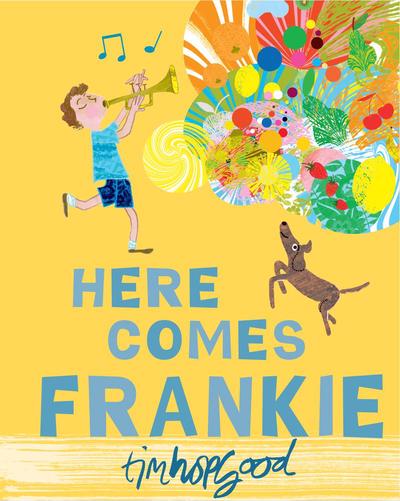
Tim Hopgood
It’s hard to believe that ten years have passed since Frankie first marched down Ellington Avenue playing his trumpet and turned a grey, quiet street into a noisy, colourful carnival scene.
Here Comes Frankie! (2008) is a book that’s taken me out of my studio and into schools, working with children of all ages. Through it I discovered the world of synaesthesia. More recently, when the book was selected by CLPE to be part of their Power of Pictures project, I’ve seen the power of expression and character development through drawing, and its positive impact on literacy in schools.
I had no intention of writing a picture book about synaesthesia, in fact I’m not sure I even knew what synaesthesia was. My starting point was simply to create a book to encourage young children to learn to play a musical instrument or at least give it a try. Giving it a try is more in line with my own experience, having been in the recorder club at primary school and then the proud owner of a 1970s Hohner Melodica (its bold green and cream colour combination was the big draw for me) and the offer of 12 weeks of violin lessons seemed like a must. Unfortunately the violin and I didn’t bond. I desperately wanted to: I loved carrying the case, I loved playing with the bow and I loved the smell of my violin, but when bow, violin and I got it together it was clear we weren’t made for each other. I had high hopes of moving on to the clarinet or the oboe, but my parents weren’t so enthusiastic and declared me ‘non-musical’ and that was that.
Having encouraged my own children to play musical instruments, I wanted to write a book about not giving up, about persevering and the joy that music can bring to our lives. I’ve always been fascinated by how music can change your mood or the atmosphere in a room. But how do you show music in a picture book?
That’s what I asked myself when I came to illustrate Here Comes Frankie! (2015). As a starting point I looked at the paintings of Wassily Kandinsky; I remembered from school that Kandinsky had created a series of paintings in response to music. I noticed that some of his mark making looked like musical notes, some of it mathematical and other elements looked very much like hands playing abstract instruments. The arrangement of these elements was dynamic and joyful.
And then quite by accident I came across an article online about how Kandinsky thought he heard his paintbox hiss. I read with great excitement how he was convinced the colours in his paintbox made different noises and that he was most likely a synaesthete. And suddenly a whole world of different possibilities opened up for Frankie and me. Imagine his surprise when Frankie first blows his trumpet only to discover that he can not only hear the sound, but see and smell it too!
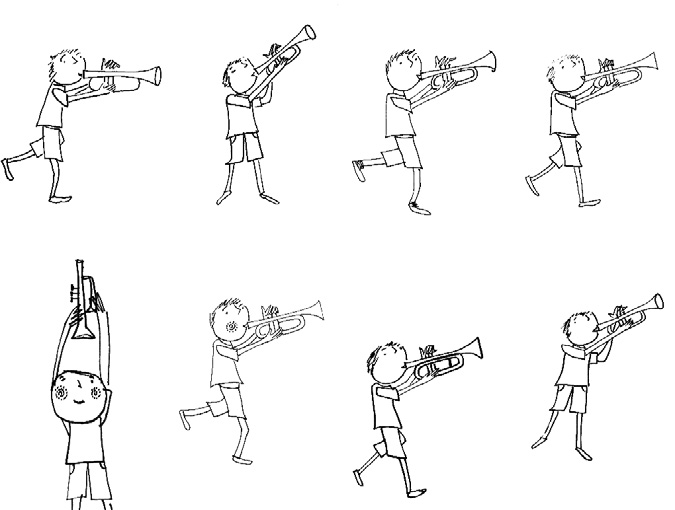
From Here Comes Frankie!. Copyright © 2015 Tim Hopgood. Published by Macmillan Children’s Books.
I had already decided that Frankie would learn to play the trumpet (not the violin!) and that the book would reference the jazz era around the 1950s and 60s. Why? Well, because it’s an era that really fascinates me: a time when ideas in art and music seemed particularly fluid, groundbreaking and exciting and I wanted to capture this excitement in my book.
I also looked at the experimental work of Jackson Pollock. The raw energy of his splatter paintings seemed to me like a good place to start when it came to illustrating sounds. I decided to show Frankie’s first attempts at playing the trumpet in rough scribbles and cut-up collage shapes that were awkward and rough, a direct visualisation of the noises he was making.
To slow the whole process down, I didn’t want him to be a musical maestro overnight, there had to be a moment when things weren’t going well, so I divided the pages up into separate panels. I call these ‘pack-horse’ spreads because they are pages that carry a lot of information. Having a series of pack-horse spreads enabled me to then have a run of high impact pages towards the end of the book that are bursting with colour and movement and very little text.
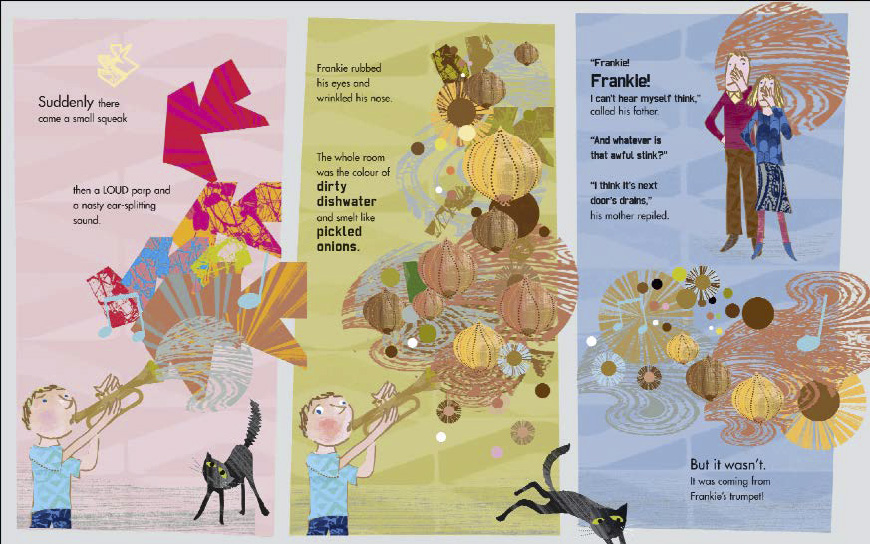
From Here Comes Frankie!. Copyright © 2015 Tim Hopgood. Published by Macmillan Children’s Books.
As the book progresses, the pages gradually become more colourful and the shapes that Frankie creates become more fluid and appealing to reflect the development of his musical skills. Eventually we come to a double-page spread that is bursting with colour and this is the moment that Frankie fills his house with wonderful patterns of sound before heading outside and filling Ellington Avenue with the sound of sunshine.
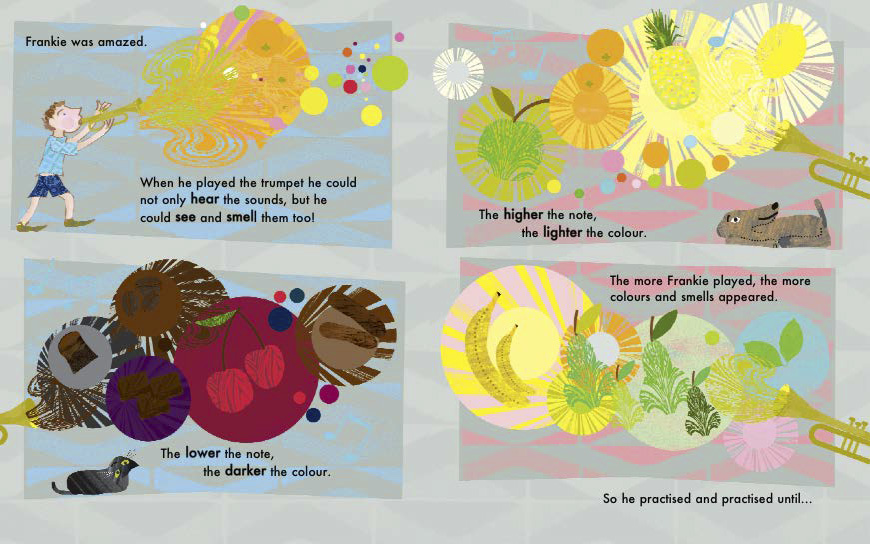
From Here Comes Frankie!. Copyright © 2015 Tim Hopgood. Published by Macmillan Children’s Books.
Years later I was able to combine my love of music and art again when my editor at OUP Children’s Books asked if I had ever considered illustrating a classic. I don’t think he was considering it to be a classic song, but I seized the moment and showed him a pencil rough I had created of What a Wonderful World written by Bob Thiele and George David Weiss (2015). Following the success of What a Wonderful World I’ve since illustrated three more classic songs: Walking in a Winter Wonderland (2016), Moon River (2018) and Singing in the Rain (2017). I like the idea that in my own way I’m keeping these songs alive and introducing them to a new, younger audience.
People are generally surprised when I tell them that ‘Singing in the Rain’ was written in 1929. Any song that’s been around that long is special. It means people connect to it. The song was a hit long before the film was ever made. In fact, the film was used as a vehicle to make the song a hit all over again! But I guess the reason we love the song so much is that iconic dance scene by Gene Kelly.
A hit song that already has strong visual associations is possibly dangerous ground for a picture-book project. When I told friends which song I was doing next I was surprised by their response, ‘Oh brilliant, I love that song, and will you be drawing Gene Kelly dancing in the rain?’. They were surprised to hear that no, I would not be doing that, although in truth, there is a nod to Kelly right at the start of the book, because I want people to make the connection. I very much hope that parents and teachers will share that classic dance scene and the wonders and skill of Kelly with the little ones in their life.
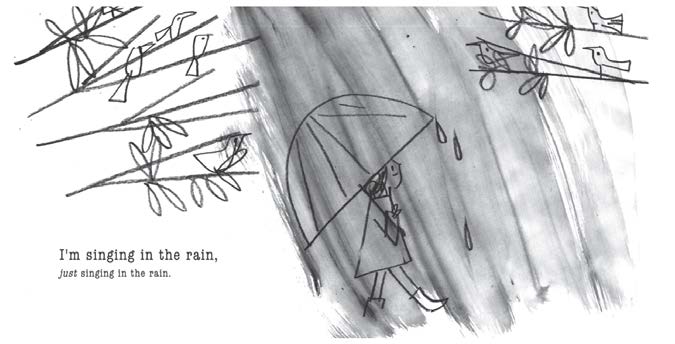
Singing in the Rain. Layout for pp.4–5. Illustration © 2017 Tim Hopgood. Published by Oxford University Press.
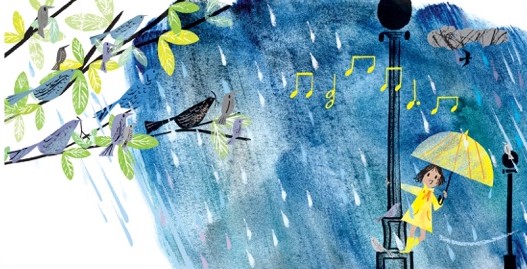
Singing in the Rain. Final illustration for pp.4–5. Illustration © 2017 Tim Hopgood. Published by Oxford University Press.
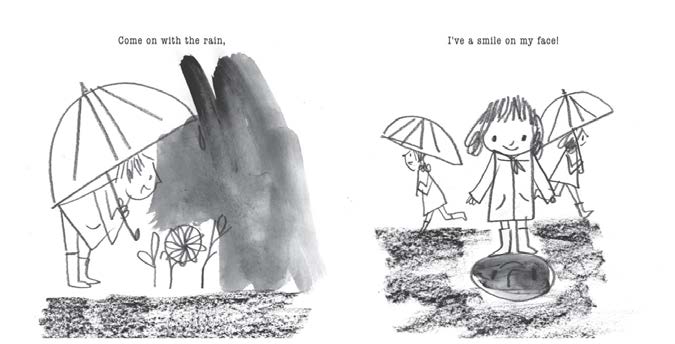
Singing in the Rain. Layout for a double spread. Illustration © 2017 Tim Hopgood. Published by Oxford University Press.
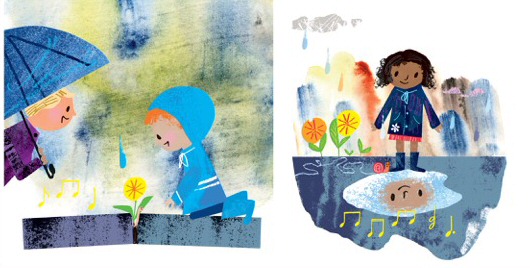
Singing in the Rain. Final illustration for a double spread. Illustration © 2017 Tim Hopgood. Published by Oxford University Press.
Can the words from a song make a good picture book? I think they can. To me ‘Singing in the Rain’ is about life. It’s about how rain is a powerful life source. It’s about how rain connects us: after all, moisture created in the rainforest falls in our cities. In the book this is all seen through the eyes of a child. It’s children who tend to notice the cracks in the pavement; when did you last stop and really look into a puddle? I’m guessing you can’t remember because as adults we just don’t have the time! And actually rain is a huge inconvenience. If I announce that it’s raining I doubt that many of you would jump up with sheer delight, you’re more likely to groan and check the travel news. Rain means delays. But to a child, rain means dressing up in bright, funny clothing. Rain means wellies. Rain means puddles. Puddles mean splashing! And splashing is fun. So now you’re aged four again, you’re in your rainy day gear, you’ve got your wellies on and you’ve just been handed an umbrella. It’s a bit windy, perfect, because you feel like flying. One, two, three and you’re off. So now you’re flying high above the city heading for where? The rainforest of course!
And as you drop through the clouds you feel the warm, damp air and suddenly your head is filled with the sound of amazing tropical birds. And having grown up in the city, you’ve never seen anywhere so green and lush. You can hear a roar, but it’s not the roar of a tiger, it’s continuous and powerful and you can’t help but be drawn towards it.
Now the noise is deafening . . . and what’s the source of the noise? A wonderful, powerful waterfall. It’s time to head back now, time to leave the rainforest behind, time to return to the other side of the rainbow, back to the city, back to reality, back down to earth.
At first glance, what might appear to be ‘just the words from a song’ can in fact, as I’ve come to discover, be a terrific springboard for some spectacular visual storytelling.
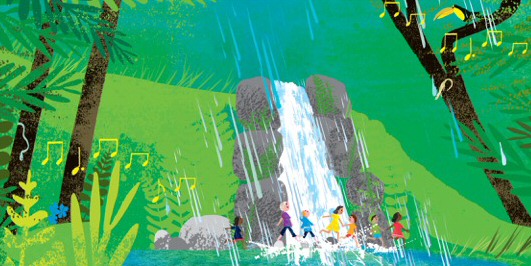
Singing in the Rain. Illustration © 2017 Tim Hopgood. Published by Oxford University Press.
Works cited
Hopgood, Tim (2008) Here Comes Frankie! London: Macmillan Children’s Books.
Feed, Arthur and Brown, Nacio Herb Brown (illus. Tim Hopgood) (2017). Singing in the Rain. Oxford Children’s Books.
Tim Hopgood is an award-winning picture-book creator. His first book, Our Big Blue Sofa (2006) won the Read It Again! Award in 2007. In 2008, he won the Booktrust Early Years Award for Best Emerging Illustrator for Here Comes Frankie! (2008). Since then his books have been translated into over 20 different languages and he has been nominated for the Kate Greenaway Medal six times. To find out more visit www.timhopgood.com.
